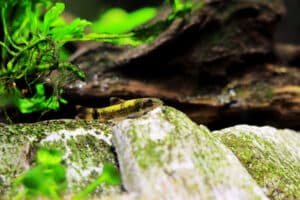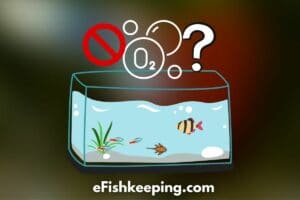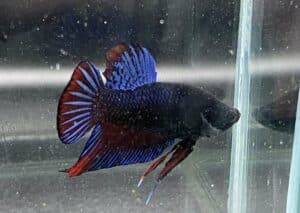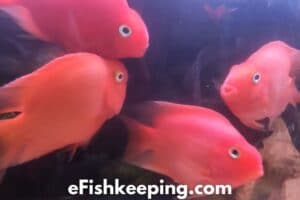Are you thinking of adding clown loach fish to your 125-gallon tank, and are wondering how many clown loaches you should place there?
As a general rule of thumb, each clown loach will need around 30 gallons of tank volume to stay healthy and happy. So, for a tank sized at 125 gallons, this means that around 4 to 5 clown loaches would be appropriate. However, given the very social nature of clown loaches, it’s usual for tropical fish enthusiasts to keep a minimum of 5 clown loaches together in one tank.
In this article, we explore the clown loach and its behavioral characteristics as these explain why each clown loach needs a relatively large tank volume. I will also explain how you can set up your tank environment to ensure optimal happiness for your clown loaches, and also provide some suggestions for suitable tank mates.
A Quick Introduction To The Clown Loach
The clown loach is a tropical freshwater fish that originates from Borneo and Sumatra in Indonesia. In its home territory, it can grow into a relatively large fish measuring over a foot in length.
The clown loach is a very popular, schooling, tropical fish with its colorful orange body with three black stripes, one of which covers the head.
A clown loach has red fins, with a forked rear fin. They also have two pairs of barbels at the end of their snout. The barbels help the clown loach to search out food morsels on the river or tank bottom.
Clown loaches are active and lively fish making them interesting to watch as they move around the aquarium tank.
The peaceful temperament of the clown loach makes it easy to mix with other freshwater tropical fish species.
The captive clown loach lifespan varies and is very much dependent on the care routine and the diet that it receives. If well cared for, clown loaches in aquariums can live for ten years or more.
Typical Captive Clown Loach Size
As with lifespan, the size of a clown loach will be dependent on its environment, including tank size, and care plan.
Clown loaches in tanks can grow to a length of around 10 inches or more, making a healthy clown loach a relatively sizable fish. A clown loach will grow relatively rapidly in the first five years of its life, and then its growth rate will slow down after that.
The key factors that will keep your clown loaches happy, and hence determine how big your clown loaches will get, include the following:
- Food Quality and Variety: Clown loaches are omnivores and love to forage and eat live food if they can get it. A balanced diet, similar to that eaten in the wild will have a big impact on the size of a clown loach in an aquarium. They can eat fruit and vegetables combined with brine shrimps, snails, worms, slugs, and insects. Clown loaches are bottom feeders so make sure that the feed you give sinks and does not float. Also, make sure that if you are feeding fruit and vegetables, these are clean and pesticide-free to avoid water contamination. Slight ‘off’ fruit and vegetables can be fed to clown loaches, they won’t mind this.
- Water Quality and Temperature: Good oxygen levels and clean water at a temperature of 24-29°C will contribute to optimal growth.
- Space: Freedom to exercise and roam as in the natural habitat will keep your Clown loaches happy and content, hence the suggested 30 gallons of tank volume per clown loach, particularly if you are setting up a community tank of mixed fish species.
- Companions: As the clown loach is a social fish that likes to live in a school, tank mates to play with are an important factor to ensure a happy and content disposition.
- Vegetation: Plenty of living plants throughout your aquarium, submerged as well as floating, will provide some dietary variation as well as a varied environment with shady places to hide.
Clown loach Behavior and Characteristics
It’s useful to understand clown loach behavior as this impacts the minimum size of tank required, and the maximum number of Clown loaches recommended for a certain tank size.
Typical clown loach behavior can be summarized as follows:
- Playful: Clown loaches enjoy active play with other clown loaches, and can often be seen chasing each other around the aquarium.
- Active: The clown loach will be most active and energetic during darkness and during the early morning. However, the clown loach can be encouraged to be active during the day with a blue light in the tank.
- Social/Non-Aggressive: Clown loaches form schools or shoals and are happy in groups. They are also good community fish that are able to tolerate other freshwater tropical fish species without aggression. The only word of caution here is that clown loaches may sometimes try and eat very small fish or fry that can fit into their mouth. And note that sometimes clown loaches will get mildly agitated with each other. This is usually part of the process to establish the social hierarchy and rarely escalates to fights or more violent behavior.
- Amusing: Clown loaches show some endearing and amusing behaviors such as hiding in, and popping out of, tank vegetation or structures made of rock or wood that can be placed in the tank. They also have a tendency to dig and bury themselves in sand if it is deep enough.
- Strange: You might see a clown loach lying on one side near the bottom of the tank. Initially, it may appear dead, and although a somewhat strange behavior, it’s quite normal for a clown loach to do this. When a Clown loach does this, the chances are it is tired out after all that activity chasing around the tank and it needs a rest!
- Hierarchical: The Clown loach social hierarchy is usually led by a female fish, and young clown loaches can often be seen following and mimicking the alpha female’s movements and activities.
- Territorial: If you mix male and female clown loaches in a tank, note that male clown loaches are territorial. So, you should have a maximum of one male for every four females in a school. Otherwise, fights over territory or breeding rights are likely to break out.
Tank Requirements
Apart from the right tank size, based on the 30-gallon per clown loach rule-of-thumb, you will need to make sure that the quality of the water in the tank is kept in optimal condition.
It needs to be extremely clean, warm, and well-aerated with good oxygen levels. This means you will need a good water filtration system and will need to change the water on a regular basis.
In terms of the physical environment, a clown loach will be happiest when its tank environment is similar to its natural river, or lake, environment.
You can achieve this by providing a layer of small-grade gravel and sand at the bottom of the tank, and by placing live plants throughout the different layers of the tank, supplemented with natural-looking ornaments, driftwood, or rocks placed at the bottom of the tank.
Tank Mates
A 125-gallon aquarium is a relatively big and heavy tank and typically would measure 72″ x 18″ x 21″. With all that space, if you follow the recommendation to keep five clown loaches in a 125-gallon tank you may want to add some other fish compatible with clown loaches. B
ut it will be important to take into account the space requirements of these other fish.
As clown loaches tend to spend a lot of time near the bottom of the tank, compatible tank mates can be fish that prefer to spend time in other parts of the tank. Having said that, clown loaches also get on with other social and placid fish that spend time at the bottom of the tank such as Corydoras or Pleco.
Some other suitable tank mates for clown loaches include some types of African Cichlids, Tetras, Tiger Barbs, Silver Dollar Fish, and Gouramis.
Conclusion
So, how many clown loaches in a 125-gallon tank? I would say around five is appropriate, this would give 25 gallons per fish and will allow the clown loaches to form a small school. The social aspect of the clown loach’s personality should not be underestimated.
Keeping clown loaches in groups of less than 5 will result in unhappy fish and timid behavior. That would be a shame given that a key attraction of keeping clown loaches is their playful, active, and amusing behavior!
Read More:
Hi! I’m Praveen Ghoshal, the founder of eFishkeeping.com. Inspired by my Dad, I got interested in fishkeeping when I was a kid. Since then, I have been involved with this hobby. Currently, I have 3 fish tanks at our home, and I enjoy this hobby with my full family. Read more about me here.








